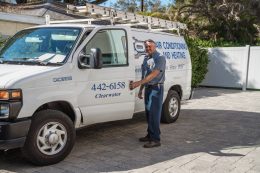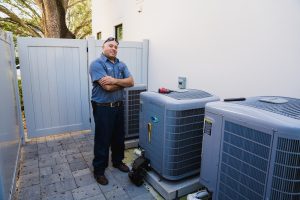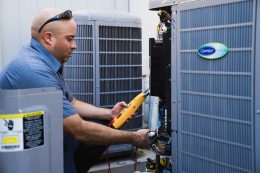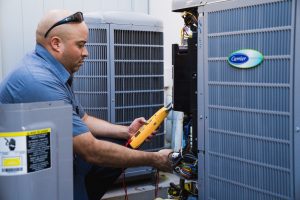How Your Central Air Works
Air conditioning is a wonder of modern life. It makes it possible to live and thrive anywhere in the world during even the hottest of summers. Nowadays, many families enjoy the benefits of air conditioning via their central air systems. While air conditioning is ubiquitous throughout the country, not many people are actually familiar with how it works. Here’s a brief rundown on how your home’s central air system works.
 The Air Conditioning Process
The Air Conditioning Process
Since their invention, all air conditioners operate in much the same way. The indoor of a home is cooled by the removal of warm air and humidity. The cold air is circulated throughout the house, while the heat and humidity are released outside. Refrigerators have three principal mechanical elements: a compressor, a condenser coil, and an evaporator coil. The manipulation of a refrigerant between these three components is what cools your home.
- The refrigerant gas is pressurized and heated by the compressor, then sent to the condenser coil where it is converted into a liquid.
- The liquid refrigerant is sent to the indoor evaporator coil where it evaporates and cools the coil.
- Indoor air is blown across the coil, allowing the refrigerant to absorb the home’s indoor heat.
- While the cooled air is circulated throughout the home, the heated refrigerant gas is returned to the compressor coil where the process begins again.
- The heated indoor air and humidity are released outside.
Elements of the AC System
For everything to work according to plan, every part of the AC system needs to be working properly. In the outdoor unit, you’ll find the compressor, the condenser coil, the fan, and all the relevant electrical components. On the inside of the home is where the evaporator coil is usually located. In order for air and refrigerant to move freely between the inside and outside units, they are connected by a series of pipes and refrigeration lines. The refrigerant itself is required to absorb the heat in the home which cools off the environment. Some ducts act as air tunnels that occupy various parts of the inside of your house that are required to circulate the air. Then, there is a thermostat that controls the whole system.
 Maintaining Your AC
Maintaining Your AC
There are things you can do to make sure your home’s air conditioning is working the way it should. Replace your air filters every three months throughout the year and monthly during the peak of summer. Also, install a programmable thermostat. By automatically raising your home’s temperature at night and while you’re at work—and lowering it when you’re at home—a programmable thermostat can help you cut back on monthly energy bills while reducing strain on your AC.
Taking small steps like these is enough to ensure that your home’s air conditioner will give you the cool air you need at the times you need it most. For emergency repair or regular maintenance, contact the experts at Cox Air at (727) 442-6158. Give us a call today!
Tips to Negate Foul Air-Conditioning Smells
Many have experienced this in the past: you turn on your air conditioner to make your home more comfortable, but when it kicks in, you notice a bad smell emanating from the vents. Air conditioner odors can occur for several reasons. Knowing the cause of the scent is essential to fixing the issue and making it go away. Keep reading to learn more about why the smells appear and how to get rid of them.
 Why Does My Air Conditioner Stink?
Why Does My Air Conditioner Stink?
Rotten smells coming from the AC can be the result of many different things. One of the most common AC issues people experience is referred to as “Dirty Sock Syndrome.” This occurs when bacteria and mold build up on the evaporator coil and create a moldy odor that is similar to dirty socks. Another common AC smell is heating or burning wires. This is a distinct odor that is caused by a loose cable or short-circuited board. Do you smell the scent of rotten eggs coming from your vents? If so, it may be caused by a dead animal in the air duct. This is a serious situation that will require professional help to fix.
How to Remove AC Odors
The causes listed above are just a few of the many things that can cause a bad air conditioner smell. To get rid of the smell, use the tips below.
- Clean the AC: Though some parts of the AC must be professionally cleaned, you can clean the air filters, outdoor unit, and ducts on your own. All you need is a rag, brush, and a vacuum cleaner with a long hose attachment. Cleaning will help to remove and prevent any bacterial buildup.
- Install Duct Filters: These help to control odor and keep your ducts cleaner. You can easily find them at your local home improvement store.
- Perform Seasonal Maintenance: Getting your system inspected regularly helps it to stay clean and operate efficiently. The technician will also keep their eye out for any issues that could create a foul odor in the future and repair them before they progress any further.
- Use Artificial Odor Control Methods: Sometimes, the odor may not be coming from the HVAC system, but rather the air outside. In this case, you may need to rely on other odor control methods, such as candles, aerosol sprays, and incense. You can also use an air purifier or put baking soda inside the ducts.
 When to Seek Professional Help
When to Seek Professional Help
Some air conditioner issues require professional help fix. If you have done everything you can and the smell still continues, it is time to call an HVAC professional. They can inspect every inch of your HVAC system and discover the root cause of the odor. A technician can also clean every nook and cranny of the system. This is essential if your unit is severely clogged with dust and debris, or if you notice mold growth inside the air conditioner. You also need to call a professional if you suspect there is a dead animal inside one of the air ducts. Because this can cause health issues, it requires cleaning and disinfecting by a professional.
[IMAGE 2]
If you’ve noticed foul odors coming from your air conditioner, call on an expert from Cox Air to see how we can get your home smelling fresh again.
Why Indoor Air Quality Is More Toxic Than the Outdoors
Air pollution isn’t often associated with indoor air. Vehicle exhaust, combustion of fossil fuels, dust and dirt from agriculture and construction — these are some of the causes of outdoor air pollution that we’re so used to hearing about. While outdoor air pollution is harmful, however, the EPA says indoor air pollution levels are often 2-5 times higher than outdoor level. This is a conservative number because in some instances, indoor air pollutant levels can exceed levels of the same outdoor air pollutants at a level 100 times higher. This means the air inside your home or workplace can be more toxic to you than the air outdoors. Continue reading and learn how this happens.
 Radon Gas
Radon Gas
Radon occurs naturally outdoors and is produced when uranium breaks down in soil and rocks. Radon levels outdoors are harmless. Inside your home, radon gas can expose your lungs to small amounts of radiation. Breathing in radon gas for many years can damage cells in the lung’s lining and increase a person’s risk of developing lung cancer. While the risk of lung cancer from radon isn’t as high as the risk for cancer associated with smoking, combining the two does create a greater cancer risk. Radon gas gets into a building through cracks in the foundation. Levels are usually highest in the basement or crawl space.
Cleaning Supplies
Most people use a variety of cleaning products to ensure they have a clean smelling home. It’s the chemicals in the cleaning products that make your home smell fresh. Those chemicals can irritate your lungs. If you’re an elderly person, suffer from chronic illness, or have asthma, cleaning products may contribute to poor health. You may notice an increase in headaches, respiratory problems, and even skin rashes. The best way to have a clean smell in your home is to open the windows and let things air out naturally.
Volatile Organic Compounds

Cigarette Smoke
Another common indoor air pollutant comes from cigarette smoke. Called environmental tobacco smoke, this includes smoke exhaled by the smoker, and what comes from the actual smoking product. The cigarette, cigar, or pipe emits side smoke. Both pollute indoor air. When you consider that indoor air doesn’t get filtered as quickly as air outside, it’s not hard to see how cigarette smoke can create a more toxic environment inside a home or building. Environmental tobacco smoke contains high levels of particulate matter (PM). PM is also called particle pollution and is a mixture of solid particles and liquid droplets. High PM levels indoors may result in health issues. Households where people smoke have a higher PM level than those that are smoke-free.
You can reduce indoor air pollution by paying attention to the cleaning supplies you use, being aware of products with VOCs, and not smoking indoors. Even so, one of the biggest sources of indoor air pollution is cooking. If your stove doesn’t have a good ventilation system, instead of pushing cooking fumes outside, they remain indoors where you breath them in.
Contact Cox Air today if you’d like more information about how you can maintain healthy indoor air quality.












Recent Comments